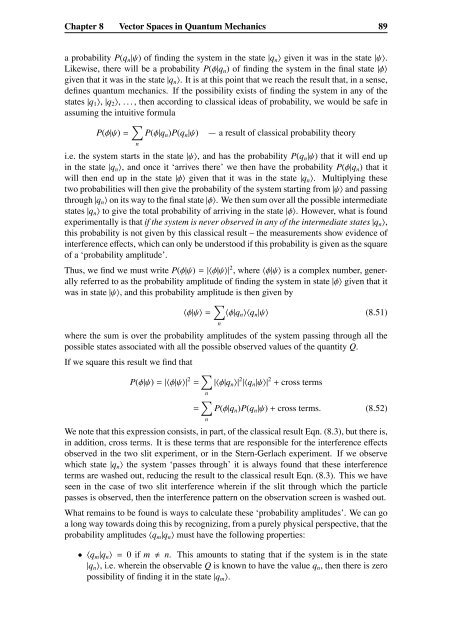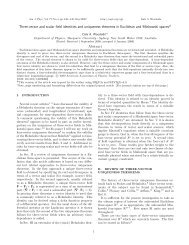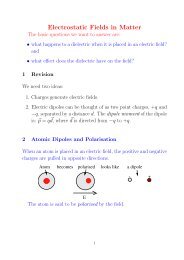Chapter 8 Vector Spaces in Quantum Mechanics
Chapter 8 Vector Spaces in Quantum Mechanics
Chapter 8 Vector Spaces in Quantum Mechanics
You also want an ePaper? Increase the reach of your titles
YUMPU automatically turns print PDFs into web optimized ePapers that Google loves.
<strong>Chapter</strong> 8 <strong>Vector</strong> <strong>Spaces</strong> <strong>in</strong> <strong>Quantum</strong> <strong>Mechanics</strong> 89a probability P(q n |ψ) of f<strong>in</strong>d<strong>in</strong>g the system <strong>in</strong> the state |q n 〉 given it was <strong>in</strong> the state |ψ〉.Likewise, there will be a probability P(φ|q n ) of f<strong>in</strong>d<strong>in</strong>g the system <strong>in</strong> the f<strong>in</strong>al state |φ〉given that it was <strong>in</strong> the state |q n 〉. It is at this po<strong>in</strong>t that we reach the result that, <strong>in</strong> a sense,def<strong>in</strong>es quantum mechanics. If the possibility exists of f<strong>in</strong>d<strong>in</strong>g the system <strong>in</strong> any of thestates |q 1 〉, |q 2 〉, . . . , then accord<strong>in</strong>g to classical ideas of probability, we would be safe <strong>in</strong>assum<strong>in</strong>g the <strong>in</strong>tuitive formula∑P(φ|ψ) = P(φ|q n )P(q n |ψ) — a result of classical probability theoryni.e. the system starts <strong>in</strong> the state |ψ〉, and has the probability P(q n |ψ) that it will end up<strong>in</strong> the state |q n 〉, and once it ‘arrives there’ we then have the probability P(φ|q n ) that itwill then end up <strong>in</strong> the state |φ〉 given that it was <strong>in</strong> the state |q n 〉. Multiply<strong>in</strong>g thesetwo probabilities will then give the probability of the system start<strong>in</strong>g from |ψ〉 and pass<strong>in</strong>gthrough |q n 〉 on its way to the f<strong>in</strong>al state |φ〉. We then sum over all the possible <strong>in</strong>termediatestates |q n 〉 to give the total probability of arriv<strong>in</strong>g <strong>in</strong> the state |φ〉. However, what is foundexperimentally is that if the system is never observed <strong>in</strong> any of the <strong>in</strong>termediate states |q n 〉,this probability is not given by this classical result – the measurements show evidence of<strong>in</strong>terference effects, which can only be understood if this probability is given as the squareof a ‘probability amplitude’.Thus, we f<strong>in</strong>d we must write P(φ|ψ) = |〈φ|ψ〉| 2 , where 〈φ|ψ〉 is a complex number, generallyreferred to as the probability amplitude of f<strong>in</strong>d<strong>in</strong>g the system <strong>in</strong> state |φ〉 given that itwas <strong>in</strong> state |ψ〉, and this probability amplitude is then given by∑〈φ|ψ〉 = 〈φ|q n 〉〈q n |ψ〉 (8.51)nwhere the sum is over the probability amplitudes of the system pass<strong>in</strong>g through all thepossible states associated with all the possible observed values of the quantity Q.If we square this result we f<strong>in</strong>d that∑P(φ|ψ) = |〈φ|ψ〉| 2 = |〈φ|q n 〉| 2 |〈q n |ψ〉| 2 + cross termsn∑= P(φ|q n )P(q n |ψ) + cross terms. (8.52)nWe note that this expression consists, <strong>in</strong> part, of the classical result Eqn. (8.3), but there is,<strong>in</strong> addition, cross terms. It is these terms that are responsible for the <strong>in</strong>terference effectsobserved <strong>in</strong> the two slit experiment, or <strong>in</strong> the Stern-Gerlach experiment. If we observewhich state |q n 〉 the system ‘passes through’ it is always found that these <strong>in</strong>terferenceterms are washed out, reduc<strong>in</strong>g the result to the classical result Eqn. (8.3). This we haveseen <strong>in</strong> the case of two slit <strong>in</strong>terference where<strong>in</strong> if the slit through which the particlepasses is observed, then the <strong>in</strong>terference pattern on the observation screen is washed out.What rema<strong>in</strong>s to be found is ways to calculate these ‘probability amplitudes’. We can goa long way towards do<strong>in</strong>g this by recogniz<strong>in</strong>g, from a purely physical perspective, that theprobability amplitudes 〈q m |q n 〉 must have the follow<strong>in</strong>g properties:• 〈q m |q n 〉 = 0 if m n. This amounts to stat<strong>in</strong>g that if the system is <strong>in</strong> the state|q n 〉, i.e. where<strong>in</strong> the observable Q is known to have the value q n , then there is zeropossibility of f<strong>in</strong>d<strong>in</strong>g it <strong>in</strong> the state |q m 〉.
















